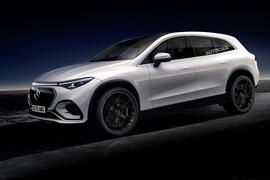
New car is being developed with "AMG first, EV second" mantraElectric GT SUV will use advanced tech to take on Eletre and Cayenne EVs
Mercedes-AMG’s answer to the Lotus Eletre and upcoming electric Porsche Cayenne will be launched in two years and be one of the most powerful cars the brand has ever produced.
Currently known as the electric GT SUV – a name it is understood could be carried into production – the super-SUV has hit the road in prototype form for the first time and the production version is set to reach UK forecourts in 2027. It is the first SUV that AMG has developed independent of parent Mercedes-Benz.
The EV will sit on the AMG.EA architecture, which will be used first for a four-door production version of the Vision AMG concept in 2026. AMG.EA will feature 800V and advanced axial-flux electric motors in both twin and tri set-ups, with outputs well over 1000bhp expected to be offered.
Developed by Yasa, the Oxfordshire-based firm owned by Mercedes-Benz, these motors each develop up to 480bhp and 590lb ft and are seen by AMG as a key performance differentiator for its new SUV. Among the performance benchmarks for the new AMG model is the 906bhp Lotus Eletre R.
AMG’s dedicated SUV will be heavily focused on road-going performance but insiders have told Autocar it will offer variable ride height control to improve ground clearance in off-road use.
As for styling, prototypes reveal that its bold-looking design will incorporate elements that provide clear visual connections with its saloon sibling.
The front end is also set to feature a new interpretation of AMG’s Panamericana grille, together with distinctive headlights that include the three-pointed star graphics.
![]()
Flared wheel arches and wide rear haunches dominate the flanks, while retractable door handles – as seen on the EQE SUV and EQS SUV – increase aerodynamic efficiency.
Although AMG’s existing combustion-engined GLE-based models come in both SUV and SUV-coupé bodystyles, its new electric model will be offered solely in SUV form, with a “relatively upright tailgate and angled rear window” providing “the best balance between form and load-carrying space”, insiders have told Autocar.
Dimensionally, the new model sits between the 4863mm-long EQE SUV and 5125mm-long EQS SUV. Inside, it adopts a unique design for the dashboard and displays, together with new AMG.OS software.
“SUVs have been among our most popular models for many years,” AMG CEO Michael Schiebe told Autocar. “We are responding to this by offering customers a high-performance off-roader based on the AMG.EA platform. Our new high-performance architecture follows a clear philosophy: AMG first, EV second.”
AMG is remaining tight-lipped about the battery technology. However, Autocar has been told it will introduce a different chemistry combination to offer greater efficiency and a longer range than the existing lithium-nickel-manganese-cobalt battery used by existing electric-powered AMG models.
Extensive development is also being done on heat management, especially around liquid cooling, to support much faster charging rates. For reference, today’s Mercedes-AMG EQE 53 4Matic+ uses a 90.6kWh (usable) pack that has a claimed maximum range of 321 miles and can support a charging speed of 170kW – good for a top up of 112 miles of range in just 15 minutes.
Additional new software developments and inverter technology developed in partnership with Mercedes’ High Performance Powertrain division in Brixworth are also on the way, Autocar has been told.
The new AMG SUV is underpinned by double-wishbone and multi-link suspension featuring the company’s newly introduced Active Ride Control system – a set-up also being readied for its new electric saloon.
Already incorporated on the current SL, GT and the latest evolution of the 45-year-old G-Class, Active Ride Control features hydraulic pumps for each wheel to help reduce body roll while providing constant self-levelling properties.
Without traditional roll bars connecting the two opposing wheels front and rear, it can also isolate the compression and rebound characteristics at each wheel in a bid to improve the ride over AMG’s earlier suspension developments.
Additionally, this set-up will support an automatic reduction in ride height at higher speeds for added aerodynamic efficiency.
Production of the new SUV will take place alongside the upcoming saloon at Mercedes’ Sindelfingen facility in Germany.